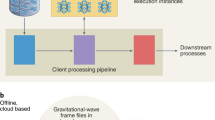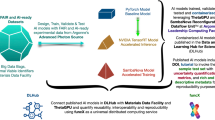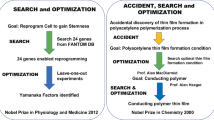Abstract
The development of reusable artificial intelligence (AI) models for wider use and rigorous validation by the community promises to unlock new opportunities in multi-messenger astrophysics. Here we develop a workflow that connects the Data and Learning Hub for Science, a repository for publishing AI models, with the Hardware-Accelerated Learning (HAL) cluster, using funcX as a universal distributed computing service. Using this workflow, an ensemble of four openly available AI models can be run on HAL to process an entire month’s worth (August 2017) of advanced Laser Interferometer Gravitational-Wave Observatory data in just seven minutes, identifying all four binary black hole mergers previously identified in this dataset and reporting no misclassifications. This approach combines advances in AI, distributed computing and scientific data infrastructure to open new pathways to conduct reproducible, accelerated, data-driven discovery.
This is a preview of subscription content, access via your institution
Access options
Access Nature and 54 other Nature Portfolio journals
Get Nature+, our best-value online-access subscription
$29.99 / 30 days
cancel any time
Subscribe to this journal
Receive 12 digital issues and online access to articles
$119.00 per year
only $9.92 per issue
Buy this article
- Purchase on Springer Link
- Instant access to full article PDF
Prices may be subject to local taxes which are calculated during checkout






Similar content being viewed by others
Data availability
Advanced LIGO data used in this manuscript are open-source and readily available at the Gravitational Wave Open Science Center40. Modelled waveforms used to train, validate and test our AI models were produced using the open-source PyCBC library47. The waveform family used was SEOBNRv348. The datasets generated and/or analysed during the current study are available from the corresponding author upon reasonable request.
Code availability
All the required software to reproduce our results, encompassing AI models and post-processing scripts, are open-source and readily available at the DLHub and may be found at ref. 49. Software to produce waveforms at scale in high-performance computing platforms with PyCBC may be provided upon request.
References
Abbott, B. P. et al. Observation of gravitational waves from a binary black hole merger. Phys. Rev. Lett. 116, 061102 (2016).
Abbott, B. P. et al. GWTC-1: a gravitational-wave transient catalog of compact binary mergers observed by LIGO and Virgo during the first and second observing runs. Phys. Rev. X 9, 031040 (2019).
Abbott, R. et al. GWTC-2: compact binary coalescences observed by LIGO and Virgo during the first half of the third observing run. Preprint at https://arxiv.org/abs/2010.14527 (2020).
Abbott, R. et al. Population properties of compact objects from the second LIGO–Virgo gravitational-wave transient catalog. Astrophys. J. Lett. 913, L7 (2021).
Soares-Santos, M. et al. First measurement of the Hubble constant from a dark standard siren using the Dark Energy Survey galaxies and the LIGO/Virgo binary–black-hole merger GW170814. Astrophys. J. Lett. 876, L7 (2019).
Abbott, B. P. et al. A gravitational-wave standard siren measurement of the Hubble constant. Nature 551, 85–88 (2017).
Schutz, B. F. Determining the Hubble constant from gravitational wave observations. Nature 323, 310–311 (1986).
Berti, E., Yagi, K. & Yunes, N. Extreme gravity tests with gravitational waves from compact binary coalescences: (I) inspiral–merger. Gen. Relativ. Gravit. 50, 46 (2018).
Abbott, B. et al. Tests of general relativity with the binary black hole signals from the LIGO-Virgo catalog GWTC-1. Phys. Rev. D 100, 104036 (2019).
Radice, D. et al. Dynamical mass ejection from binary neutron star mergers. Mon. Not. R. Astron. Soc. 460, 3255–3271 (2016).
Metzger, B. D. Kilonovae. Living Rev. Relativ. 23, 1 (2020).
Huerta, E. A. et al. BOSS-LDG: a novel computational framework that brings together Blue Waters, Open Science Grid, Shifter and the LIGO Data Grid to accelerate gravitational wave discovery. In Proc. IEEE 13th International Conference on e-Science 335–344 (2017).
Huerta, E. A., Haas, R., Jha, S., Neubauer, M. & Katz, D. S. Supporting high-performance and high-throughput computing for experimental science. Comput. Softw. Big Sci. 3, 5 (2019).
Weitzel, D. et al. Data access for LIGO on the OSG. In Proc. PEARC17: Practice and Experience in Advanced Research Computing 2017 on Sustainability, Success and Impact (eds Hart, D. L. & Dahan, M.) (Association for Computing Machinery, 2017).
Asch, M. et al. Big data and extreme-scale computing: pathways to convergence – toward a shaping strategy for a future software and data ecosystem for scientific inquiry. Int. J. High Perform. Comput. Appl. 32, 435–479 (2018).
Huerta, E. A. et al. Enabling real-time multi-messenger astrophysics discoveries with deep learning. Nat. Rev. Phys. 1, 600–608 (2019).
George, D. & Huerta, E. A. Deep neural networks to enable real-time multimessenger astrophysics. Phys. Rev. D 97, 044039 (2018).
George, D. & Huerta, E. A. Deep learning for real-time gravitational wave detection and parameter estimation: results with advanced LIGO data. Phys. Lett. B 778, 64–70 (2018).
Gabbard, H., Williams, M., Hayes, F. & Messenger, C. Matching matched filtering with deep networks for gravitational-wave astronomy. Phys. Rev. Lett. 120, 141103 (2018).
Lin, Y.-C. & Wu, J.-H. P. Detection of gravitational waves using Bayesian neural networks. Phys. Rev. D 103, 063034 (2021).
Wang, H., Wu, S., Cao, Z., Liu, X. & Zhu, J.-Y. Gravitational-wave signal recognition of LIGO data by deep learning. Phys. Rev. D 101, 104003 (2020).
Zevin, M. et al. Gravity Spy: integrating advanced LIGO detector characterization, machine learning, and citizen science. Class. Quantum Gravity 34, 064003 (2017).
Torres-Forné, A., Cuoco, E., Font, J. A. & Marquina, A. Application of dictionary learning to denoise LIGO’s blip noise transients. Phys. Rev. D 102, 023011 (2020).
Nakano, H. et al. Comparison of various methods to extract ringdown frequency from gravitational wave data. Phys. Rev. D 99, 124032 (2019).
Fan, X., Li, J., Li, X., Zhong, Y. & Cao, J. Applying deep neural networks to the detection and space parameter estimation of compact binary coalescence with a network of gravitational wave detectors. Sci. China Phys. Mech. Astron. 62, 969512 (2019).
Deighan, D. S., Field, S. E., Capano, C. D. & Khanna, G. Genetic-algorithm-optimized neural networks for gravitational wave classification. Neural Comput. & Applic. https://doi.org/10.1007/s00521-021-06024-4 (2020).
Miller, A. L. et al. How effective is machine learning to detect long transient gravitational waves from neutron stars in a real search? Phys. Rev. D 100, 062005 (2019).
Krastev, P. G. Real-time detection of gravitational waves from binary neutron stars using artificial neural networks. Phys. Lett. B 803, 135330 (2020).
Schäfer, M. B., Ohme, F. & Nitz, A. H. Detection of gravitational-wave signals from binary neutron star mergers using machine learning. Phys. Rev. D 102, 063015 (2020).
Khan, A., Huerta, E. & Das, A. Physics-inspired deep learning to characterize the signal manifold of quasi-circular, spinning, non-precessing binary black hole mergers. Phys. Lett. B 808, 135628 (2020).
Dreissigacker, C., Sharma, R., Messenger, C., Zhao, R. & Prix, R. Deep-learning continuous gravitational waves. Phys. Rev. D 100, 044009 (2019).
Beheshtipour, B. & Papa, M. A. Deep learning for clustering of continuous gravitational wave candidates. Phys. Rev. D 101, 064009 (2020).
Skliris, V., Norman, M. R. K. & Sutton, P. J. Real-time detection of unmodeled gravitational-wave transients using convolutional neural networks. Preprint at https://arxiv.org/abs/2009.14611 (2020).
Khan, S. & Green, R. Gravitational-wave surrogate models powered by artificial neural networks. Phys. Rev. D 103, 064015 (2021).
Chua, A. J. K., Galley, C. R. & Vallisneri, M. Reduced-order modeling with artificial neurons for gravitational-wave inference. Phys. Rev. Lett. 122, 211101 (2019).
Wei, W. & Huerta, E. A. Deep learning for gravitational wave forecasting of neutron star mergers. Phys. Lett. B 816, 136185 (2021).
Wei, W. et al. Deep learning with quantized neural networks for gravitational wave forecasting of eccentric compact binary coalescence. Preprint at https://arxiv.org/abs/2012.03963 (2020).
Cuoco, E. et al. Enhancing gravitational-wave science with machine learning. Mach. Learn. Sci. Technol. 2, 011002 (2021).
Wei, W., Khan, A., Huerta, E. A., Huang, X. & Tian, M. Deep learning ensemble for real-time gravitational wave detection of spinning binary black hole mergers. Phys. Lett. B 812, 136029 (2021).
Vallisneri, M., Kanner, J., Williams, R., Weinstein, A. & Stephens, B. The LIGO Open Science Center. J. Phys. Conf. Ser. 610, 012021 (2015).
Kindratenko, V. et al. HAL: computer system for scalable deep learning. In Proc. PEARC20: Practice and Experience in Advanced Research Computing 41–48 (Association for Computing Machinery, 2020).
Li, Z. et al. DLHub: simplifying publication, discovery, and use of machine learning models in science. J. Parallel Distrib. Comput. 147, 64–76 (2021).
Chard, R. et al. DLHub: model and data serving for science. In Proc. IEEE International Parallel and Distributed Processing Symposium 283–292 (2019).
Allen, M. G. et al. ESCAPE – addressing Open Science challenges. Preprint at https://arxiv.org/abs/2012.11534 (2020).
Chard, R. et al. FuncX: a federated function serving fabric for science. In Proc. 29th International Symposium on High-Performance Parallel and Distributed Computing 65–76, (Association for Computing Machinery, 2020).
Chard, K., Tuecke, S. & Foster, I. Efficient and secure transfer, synchronization, and sharing of big data. IEEE Cloud Comput. 1, 46–55 (2014).
Nitz, A. H. et al. PyCBC. Free and open software to study gravitational waves. https://pycbc.org/ (2021).
Pan, Y. et al. Inspiral-merger-ringdown waveforms of spinning, precessing black-hole binaries in the effective-one-body formalism. Phys. Rev. D 89, 084006 (2014).
Huerta, E. A. et al. AI-driven Gravitational Wave Detection (Data and Learning Hub for Science, 2021); https://doi.org/10.26311/ZWFW-3N68
van den Oord, A. et al. WaveNet: a generative model for raw audio. In Proc. 9th ISCA Speech Synthesis Workshop (eds Bonafont, A. & Prahallad, K.) 135–136 (2016).
Acknowledgements
We gratefully acknowledge NSF awards OAC-1931561 and OAC-1934757 (E.A.H.), OAC-1931306 (B.B.) and OAC-2004894 (I.F.). E.A.H. gratefully acknowledges the Innovative and Novel Computational Impact on Theory and Experiment project ‘Multi-Messenger Astrophysics at Extreme Scale in Summit’. This research used resources of the Oak Ridge Leadership Computing Facility, which is a DOE Office of Science User Facility supported under contract no. DE-AC05-00OR22725. This work used resources supported by the NSF’s Major Research Instrumentation program, the HAL cluster (grant no. OAC-1725729), as well as by the University of Illinois at Urbana-Champaign. DLHub is based upon work initially supported by Laboratory Directed Research and Development funding from Argonne National Laboratory, provided by the Director, Office of Science, of the DOE under contract no. DE-AC02-06CH11357. We thank NVIDIA for their continued support.
Author information
Authors and Affiliations
Contributions
E.A.H. led this work and coordinated the writing of this manuscript. A.K. developed and trained the AI ensemble, and also developed the software to scale this analysis over the entire HAL cluster and to post-process the output of the AI ensemble to estimate sensitivity and perform error analysis. X.H., M.T., M.H. and W.W. prepared the datasets and software used for training, testing and inference and conducted an independent inference study to ascertain the reproducibility of our AI ensemble. D.M. and V.K. optimized the HAL cluster, at both the hardware and software level, to maximize its throughput for AI training and inference at scale. B.B., I.F. and D.S.K. informed and guided the construction of the DLHub → funcX → HAL workflow. M.L. and R.C. ran an independent AI analysis using the workflow to establish the reproducibility and scalability of the results. All authors contributed to developing the ideas and to writing and reviewing this manuscript.
Corresponding author
Ethics declarations
Competing interests
The authors declare no competing interests.
Additional information
Peer review information Nature Astronomy thanks Elena Cuoco, Plamen Krastev and Linqing Wen for their contribution to the peer review of this work.
Publisher’s note Springer Nature remains neutral with regard to jurisdictional claims in published maps and institutional affiliations.
Rights and permissions
About this article
Cite this article
Huerta, E.A., Khan, A., Huang, X. et al. Accelerated, scalable and reproducible AI-driven gravitational wave detection. Nat Astron 5, 1062–1068 (2021). https://doi.org/10.1038/s41550-021-01405-0
Received:
Accepted:
Published:
Issue Date:
DOI: https://doi.org/10.1038/s41550-021-01405-0
This article is cited by
-
FAIR for AI: An interdisciplinary and international community building perspective
Scientific Data (2023)
-
FAIR principles for AI models with a practical application for accelerated high energy diffraction microscopy
Scientific Data (2022)
-
A FAIR and AI-ready Higgs boson decay dataset
Scientific Data (2022)
-
Computational challenges for multimodal astrophysics
Nature Computational Science (2022)
-
Precision dentistry—what it is, where it fails (yet), and how to get there
Clinical Oral Investigations (2022)



